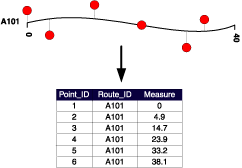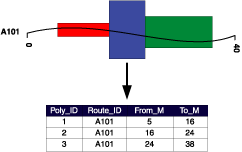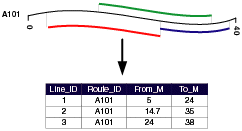You can locate point, polygon, and line features along routes.
Locating point features along routes
When you locate point features along routes, you are determining the route and measure information where your point data intersects your route data.

Locating point features along routes is useful, for example, when you need to locate any of the following:
- Signs along highways
- Wells or gauging stations along river reaches
- Stops along bus routes
- Manholes along city streets
- Valves along pipes
Locating polygon features along routes
Locating polygon features along routes computes the route and measure information at the geometric intersection of polygon data and route data. Once polygon data has been located along routes, the resulting event table can be used, for example, to calculate the length of route that traveled through each polygon.

Locating polygon features along routes is useful, for example, when you need to locate areas like these:
- Soils, spillways, areas of inundation, or hazard zones along river reaches
- Wetlands, hazard zones, or town boundaries along highways
Locating line features along routes
When you locate line features along a route, you are determining the route and measure information where the lines intersect with the route. This intersection is based on a specified cluster tolerance.

Locating line features along routes is useful, for example, when you need to tie them in with your linearly referenced data.